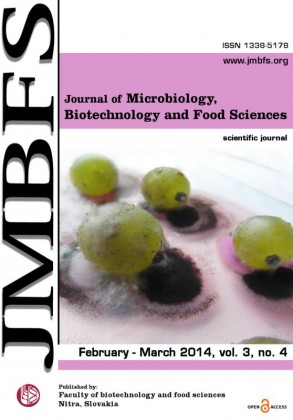COMBINED USE OF FOURIER TRANSFORM INFRARED AND RAMAN SPECTROSCOPY TO STUDY PLANKTONIC AND BIOFILM CELLS OF CRONOBACTER SAKAZAKII
Keywords:
C.sakazakii, biofilm cells, planktonic, spectroscopy, exopolysaccharideAbstract
Cronobacter sakazakii is an opportunistic pathogen, which causes necrotizing enterocolitis, bacteriaemia and infant meningitis. It has the ability to form biofilm on food contact surfaces, creating food safety risks. In this work, the phenotypic expression of planktonic and biofilm was studied by Fourier transform infrared (FTIR) and Raman spectroscopy. FTIR spectra of the biofilm cells exhibited higher intensity in the absorption bands assigned to polysaccharides, amide I, amide II vibrational mode of ester and carboxylate group. Raman spectra of the biofilm cells showed higher intensity in the absorption band assigned to tyrosine, amide III, carbohydrates, carotenoids, DNA and lipids. Understanding the chemical properties of planktonic and biofilm cells employing the two techniques helped to decipher the differences in the chemical composition between planktonic and biofilm cells. This can promote a better understanding of the persistence, survival and resistance of the biofilm cells.Downloads
Download data is not yet available.
Downloads
Published
2014-02-01
How to Cite
Sharma, G., & Prakash, A. (2014). COMBINED USE OF FOURIER TRANSFORM INFRARED AND RAMAN SPECTROSCOPY TO STUDY PLANKTONIC AND BIOFILM CELLS OF CRONOBACTER SAKAZAKII. Journal of Microbiology, Biotechnology and Food Sciences, 3(4), 310–314. Retrieved from https://office2.jmbfs.org/index.php/JMBFS/article/view/7020
Issue
Section
Microbiology
License
Copyright (c) 2014 Garima Sharma, Alka Prakash

This work is licensed under a Creative Commons Attribution 4.0 International License.
All papers published in the Journal of Microbiology, Biotechnology and Food Sciences are published under a CC-BY licence (CC-BY 4.0). Published materials can be shared (copy and redistribute the material in any medium or format) and adapted (remix, transform, and build upon the material for any purpose, even commercially) with specifying the author(s).

